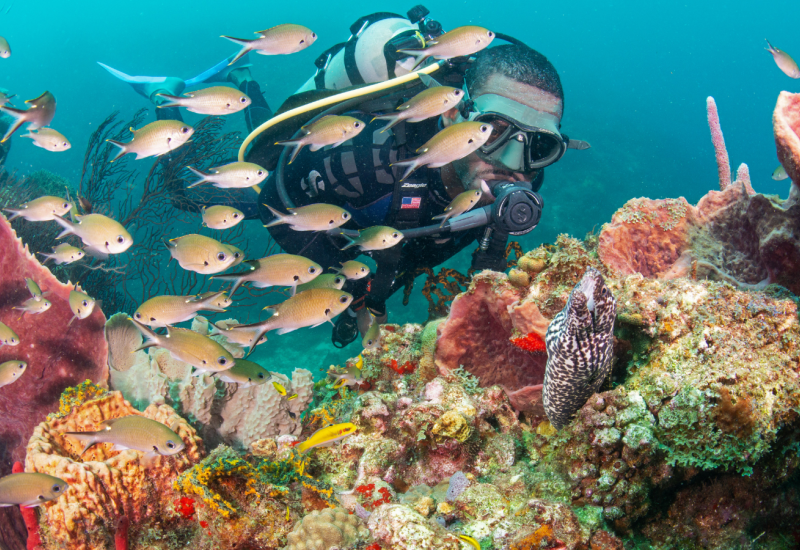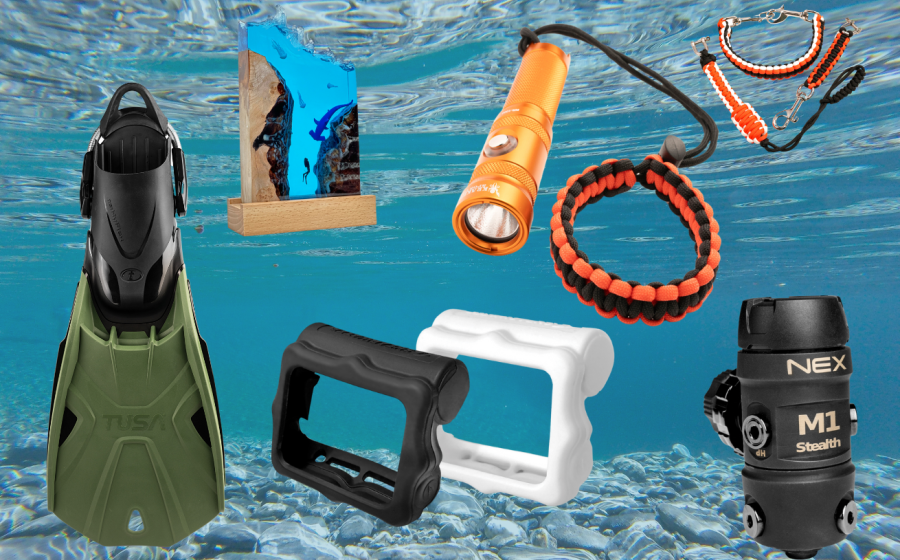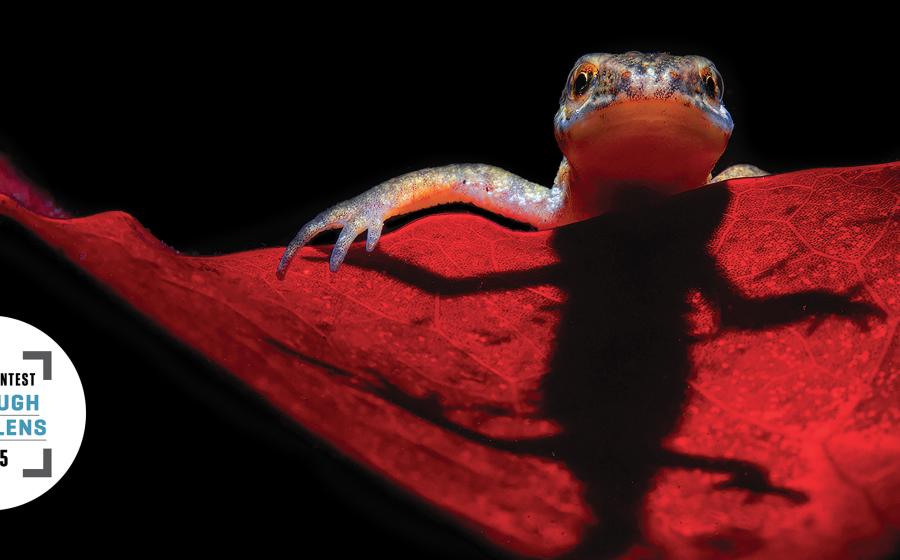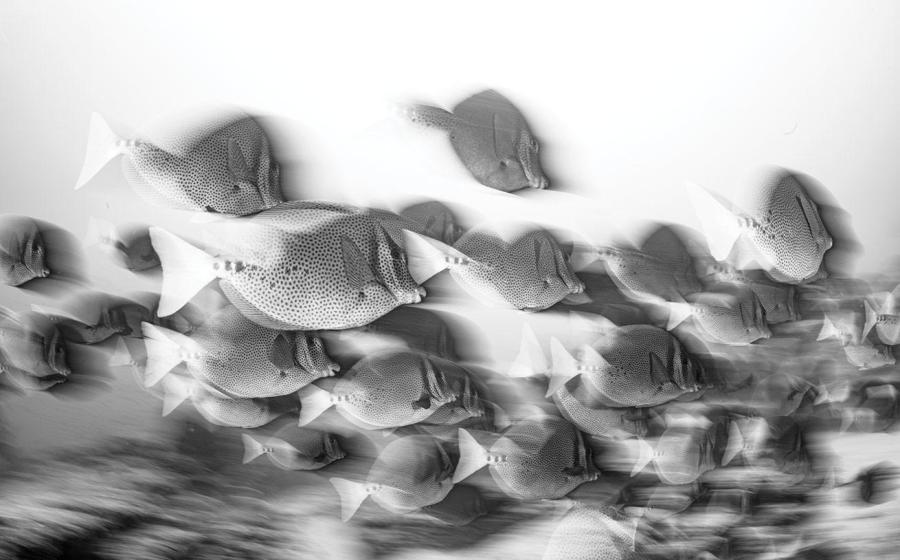Top 7 Reasons to Scuba Dive in Belize
This Central American paradise earned a host of 2014 Top 100 Readers Choice awards, including top 5 nods for the Caribbean and Atlantic’s best overall destination, big animals, wall diving and underwater photography.
You might think you’re diving in the Pacific: Belize has three of the Western Hemisphere’s four coral atolls and the second-longest barrier reef on the planet. Bowing only to Australia’s great one, the Mesoamerican Barrier Reef stretches for 700 miles along Central America’s western Caribbean coast. It’s protected as a UNESCO World Heritage Site, and is home to 500 species of fish and 65 stony corals. Gorgeous drop-offs lining the offshore atolls and cays are riddled with the dens of loggerhead turtles, green moray eels and a host of small stuff. And on the mainland, this tiny country packs enough big adventures to satisfy your inner explorer.
1. Wall Dives
You can get steep and deep from north to south all along the barrier reef, but it’s the country’s coral atolls that our readers singled out for stellar wall diving. From the surface, Belize’s atolls — Turneffe, Lighthouse Reef and Glover’s — might seem like placid beach getaways. All you have to do is pack your swimsuit, a book and sunscreen, and settle in for a week of R&R. But jump in the water and it’s a different story — your laid-back beach escape turns into an underwater Lollapalooza. All around you, shallow fringing reefs drop of to depths of more than 3,000 feet, and feature a dizzying array of fish. and colors on coral pinnacles riddled with canyons and swim-throughs. Tanks to visibility often pushing 120 feet and beyond, encounters with eagle rays and reef sharks last longer. And somehow, even the blue of the depths seems richer.
2. Gladden Split
“The sharks, the dolphins, the interactions between whale sharks and the spawn — snorkelers won’t be able to see any of that at deeper depths,” says Patty Ramirez- Capeling, owner of Splash Dive Center in Placencia, a southern coastal town. She’s talking about the fact that Belize is the only Caribbean country where scuba diving with whale sharks is permitted, though it is strictly regulated, so it’s imperative to mind your p’s and q’s. Divers hover around 60 feet where most of the action is — yes, you will see whale sharks and likely dolphins, too — at Gladden Spit and Silk Cayes Marine Reserve, 22 miles offshore. Typically, snapper spawnings coincide with the full moons March through June, although lately Ramirez-Capeling has found that the event happens a few days later. Once you’ve had the opportunity to be in the water with the world’s biggest fish, you’ll understand why readers’ votes placed Gladden Spit on our Top 5 list for best big animals in the Caribbean and Atlantic region.
3. Elasmobranchs
Another reason Belize got the nod as one of the best destinations for big animals: sharks and rays. One’s an apex predator whose presence indicates healthy reefs, and the other is pure joy to watch as it glides and twirls through water. Especially along the atolls, blacktip reef sharks are common underwater companions. If you’re the first diver in the water, you might grab bragging rights to a hammerhead or lemon encounter. Of Ambergris Caye, nurse sharks congregate by the dozens at Shark Ray Alley, a regular spot for snorkel day trips. This species is known to be docile and is often found napping — but find them when they’re active and hunting, and it’s a show guar- anteed to punch up the adrenaline. As for eagle rays, they fly loops around small reef patches, as if waiting for permission from a landing tower. For photographers, this means that with patience and smart positioning, it’s easy to capture the fish’s snout, not its backside.
4. Macro Critters
Belize also earned a spot on our list for Best Overall Diving in the region. Healthy reefs is one reason why, and a pristine marine environment translates to large populations of critters of all sizes, even the tiny guys. The oddest looking — and most vocal — is the whitespotted toadfsh. Find them by looking for drive- ways. In other words, where this fat fish makes a home, it straightens a sand path leading up to a hidey-hole so it can easily back its way into its den. As for its call, listen for a throaty croak resembling that of a frog. Train your view tighter and find nudibranchs, gobies, decorator crabs, pipehorses and seahorses. If you’re not aces at identifying these from flotsam on the reef, spend a moment topside meeting the dive staff to discover who carries a magnifying glass, extendable pointer or other accoutrements of the macro fiend.
5. The Great Blue Hole
This submarine sinkhole located near the center of Lighthouse Reef Atoll is a landmark that warrants crossing of a list, but beyond that, it’s a place that stays relevant because it produces a feeling of deep-sea adventure. For recreational divers, time is limited due to the standard dive profile that dips to 130 feet (keep in mind that the bot- tom lies at 400 feet). The site itself is exposed, so scheduled visits are more like suggestions than the rule. Inside, the experience is about the stalactites and, if you’re lucky, hammerhead and bull sharks at depths of 90 feet and beyond.
6. Great Liveaboard Cruising
Liveaboard companies know a great thing when they see it, and liveaboards have helped put Belize on the map. Departing from Belize City, luxury yachts like the Belize Aggressor III and Sun Dancer II concentrate on diving the atolls. With up to five dives a day on the menu, diving from a liveaboard can be the best way for nitrogen junkies to maximize their bottom time.
7. Topside Tours
Where to begin? For starters, plan a trip to explore a rainforest. Waterfalls, jungle rivers, and caves can be explored by hiking, rafting, tubing, and biking. Try to squeeze in a visit to one of the country’s famed Mayan archaeological sites, including Xunatunich, an ancient ceremonial center overlooking the Mopan River valley near the Guatemala border, Altun Ha, just outside of Belize City, and Lamanai, on the New River Lagoon. The country is so small — about the size of Massachusetts — that you can set of from almost anywhere on the mainland, and be back at your resort or hotel in time for happy hour and to watch the sun set.
More 2014 Top 100 Readers Choice awards: Maui | Palau | Grand Cayman

Keri WilkJaguar Preserve waterfall is a topside wonder in Belize.
This Central American paradise earned a host of 2014 Top 100 Readers Choice awards, including top 5 nods for the Caribbean and Atlantic’s best overall destination, big animals, wall diving and underwater photography.

Keri WilkStalactites hang at 150 feet underwater in the Great Blue Hole.
You might think you’re diving in the Pacific: Belize has three of the Western Hemisphere’s four coral atolls and the second-longest barrier reef on the planet. Bowing only to Australia’s great one, the Mesoamerican Barrier Reef stretches for 700 miles along Central America’s western Caribbean coast. It’s protected as a UNESCO World Heritage Site, and is home to 500 species of fish and 65 stony corals. Gorgeous drop-offs lining the offshore atolls and cays are riddled with the dens of loggerhead turtles, green moray eels and a host of small stuff. And on the mainland, this tiny country packs enough big adventures to satisfy your inner explorer.

Keri WilkA diver swims over Manta Wall in Placencia.
1. Wall Dives
You can get steep and deep from north to south all along the barrier reef, but it’s the country’s coral atolls that our readers singled out for stellar wall diving. From the surface, Belize’s atolls — Turneffe, Lighthouse Reef and Glover’s — might seem like placid beach getaways. All you have to do is pack your swimsuit, a book and sunscreen, and settle in for a week of R&R. But jump in the water and it’s a different story — your laid-back beach escape turns into an underwater Lollapalooza. All around you, shallow fringing reefs drop of to depths of more than 3,000 feet, and feature a dizzying array of fish. and colors on coral pinnacles riddled with canyons and swim-throughs. Tanks to visibility often pushing 120 feet and beyond, encounters with eagle rays and reef sharks last longer. And somehow, even the blue of the depths seems richer.

Keri WilkA Caribbean whiptail stingray.
2. Gladden Split
“The sharks, the dolphins, the interactions between whale sharks and the spawn — snorkelers won’t be able to see any of that at deeper depths,” says Patty Ramirez- Capeling, owner of Splash Dive Center in Placencia, a southern coastal town. She’s talking about the fact that Belize is the only Caribbean country where scuba diving with whale sharks is permitted, though it is strictly regulated, so it’s imperative to mind your p’s and q’s. Divers hover around 60 feet where most of the action is — yes, you will see whale sharks and likely dolphins, too — at Gladden Spit and Silk Cayes Marine Reserve, 22 miles offshore. Typically, snapper spawnings coincide with the full moons March through June, although lately Ramirez-Capeling has found that the event happens a few days later. Once you’ve had the opportunity to be in the water with the world’s biggest fish, you’ll understand why readers’ votes placed Gladden Spit on our Top 5 list for best big animals in the Caribbean and Atlantic region.

Keri WilkA glass goby on hard coral.
3. Elasmobranchs
Another reason Belize got the nod as one of the best destinations for big animals: sharks and rays. One’s an apex predator whose presence indicates healthy reefs, and the other is pure joy to watch as it glides and twirls through water. Especially along the atolls, blacktip reef sharks are common underwater companions. If you’re the first diver in the water, you might grab bragging rights to a hammerhead or lemon encounter. Of Ambergris Caye, nurse sharks congregate by the dozens at Shark Ray Alley, a regular spot for snorkel day trips. This species is known to be docile and is often found napping — but find them when they’re active and hunting, and it’s a show guar- anteed to punch up the adrenaline. As for eagle rays, they fly loops around small reef patches, as if waiting for permission from a landing tower. For photographers, this means that with patience and smart positioning, it’s easy to capture the fish’s snout, not its backside.
4. Macro Critters
Belize also earned a spot on our list for Best Overall Diving in the region. Healthy reefs is one reason why, and a pristine marine environment translates to large populations of critters of all sizes, even the tiny guys. The oddest looking — and most vocal — is the whitespotted toadfsh. Find them by looking for drive- ways. In other words, where this fat fish makes a home, it straightens a sand path leading up to a hidey-hole so it can easily back its way into its den. As for its call, listen for a throaty croak resembling that of a frog. Train your view tighter and find nudibranchs, gobies, decorator crabs, pipehorses and seahorses. If you’re not aces at identifying these from flotsam on the reef, spend a moment topside meeting the dive staff to discover who carries a magnifying glass, extendable pointer or other accoutrements of the macro fiend.

Doug PerrineDivers have the rare opportunity to scuba with whale sharks in Belize.
5. The Great Blue Hole
This submarine sinkhole located near the center of Lighthouse Reef Atoll is a landmark that warrants crossing of a list, but beyond that, it’s a place that stays relevant because it produces a feeling of deep-sea adventure. For recreational divers, time is limited due to the standard dive profile that dips to 130 feet (keep in mind that the bot- tom lies at 400 feet). The site itself is exposed, so scheduled visits are more like suggestions than the rule. Inside, the experience is about the stalactites and, if you’re lucky, hammerhead and bull sharks at depths of 90 feet and beyond.

Courtesy shutterstock.comFor the greatest topside thrills in Central America, inclucing extreme hikes, raft trips and rapples, visit Ian Aderson's Caves Branch Jungle Lodge.
6. Great Liveaboard Cruising
Liveaboard companies know a great thing when they see it, and liveaboards have helped put Belize on the map. Departing from Belize City, luxury yachts like the Belize Aggressor III and Sun Dancer II concentrate on diving the atolls. With up to five dives a day on the menu, diving from a liveaboard can be the best way for nitrogen junkies to maximize their bottom time.

Courtesy Marie SharpMarie Sharp's carrot-based hot sauce warrents space in your checked bag home, as does Lissette's secret sauce.

Courtesy Elvi'sOn Ambergris Caye, everyone eats at Elvi's Kitchen, but not everyone knows what to order to take advantage of Chef Jennie's talents. If you want to savor real Belizean flavors, ask for the tacos with rechado spice rub; When Prince Harry visited Elvi's, Jennie served spicy tacos to impress.
7. Topside Tours
Where to begin? For starters, plan a trip to explore a rainforest. Waterfalls, jungle rivers, and caves can be explored by hiking, rafting, tubing, and biking. Try to squeeze in a visit to one of the country’s famed Mayan archaeological sites, including Xunatunich, an ancient ceremonial center overlooking the Mopan River valley near the Guatemala border, Altun Ha, just outside of Belize City, and Lamanai, on the New River Lagoon. The country is so small — about the size of Massachusetts — that you can set of from almost anywhere on the mainland, and be back at your resort or hotel in time for happy hour and to watch the sun set.
More 2014 Top 100 Readers Choice awards: Maui | Palau | Grand Cayman










